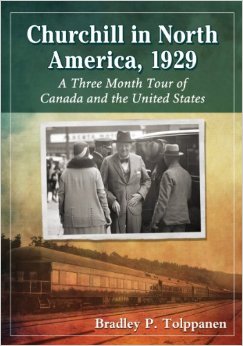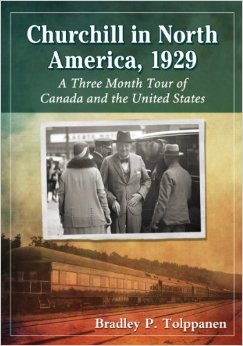
Finest Hour 168
Books, Arts & Curiosities – Churchill in North America, 1929: A Three Month Tour of Canada and the United States

September 6, 2015
Finest Hour 168, Spring 2015
Page 39
Bradley P. Tolpannen, Churchill in North America, 1929: A Three Month Tour of Canada and the United States, McFarland and Company, 2014. 272 pages, paperback. $45, Kindle, $16.49.
Review by William John Shepherd
 Churchill traveled for profit, politics, or pleasure, combining all three when in Canada and the United States, which he respectively termed the “Magnificent Dominion” and the “Great Republic.” Altogether he made eighteen roundtrips across the Atlantic.
Churchill traveled for profit, politics, or pleasure, combining all three when in Canada and the United States, which he respectively termed the “Magnificent Dominion” and the “Great Republic.” Altogether he made eighteen roundtrips across the Atlantic.

2024 International Churchill Conference
For Bradley P. Tolppanen, a librarian at Eastern Illinois University, the visit that shaped Churchill’s thinking the most was the three-month tour made from 3 August to 5 November 1929. In the company of his brother Jack, nephew Johnny, and son Randolph, Churchill covered nearly 18,000 miles traversing Canada from east to west, the Pacific coast from north to south, and the United States from west to east.
Churchill said he was “extremely comfortable” during the trip (185). And well he should have been, since much of the journey was via private rail car, either the Mt. Royal provided by the Canadian Pacific Railroad or the Loretto from American steel mogul Charles Schwab.
Accommodations were even more impressive, including the Kingsmere estate of Canadian Prime Minister W. L. Mackenzie King, the California castle of media tycoon William Randolph Hearst, various Canadian provincial residences, and a host of posh hotels like the Ritz-Carlton in Montreal and the Savoy in New York City. He was also well cared for in both Chicago and New York by financier and statesman Bernard Baruch, whom he had worked with and befriended in the First World War.
In Canada, Churchill gave fourteen speeches, beginning in Montreal and ending in Victoria, preaching imperialism and free trade. In his US speeches, plus various private chats with business, entertainment, and political elites, Churchill promoted First World War debt relief and Anglo-American security cooperation. He also gave sixty-two press interviews, wrote a dozen articles for the Daily Telegraph, and made further publishing agreements to deliver twenty-eight articles for £40,000 by June 1930.
Churchill was enamored of the natural beauty he found including Niagara Falls, Lake Louise, the Rocky Mountains (“Twenty Switzerlands rolled into one”), Yosemite Park, and the majestic Redwoods of California (107). Amazingly, he caused a minor media sensation when he caught a nearly two-hundred pound swordfish after only twenty minutes on a private yacht off Catalina Island.
Churchill also toured many sites of business and industry, such as the oil fields of Alberta, slaughterhouses of Chicago, a steel mill in Pennsylvania, and New York’s famed Wall Street, with the famous crash happening when Churchill was in town. He went briefly to Stamford, Connecticut, for the Army-Yale college football game and loved his time touring Civil War battlefields in Virginia, the part of the US he thought more like England than any other. He especially enjoyed his visit to Louis B. Mayer’s MGM movie lot at Culver City, where he got on well with Charlie Chaplain.
Although this was not a political trip, Churchill did call at the White House for a brief meeting with President Herbert Hoover and visiting Prime Minister Ramsay MacDonald. He argued that a key difference between Britain and the US was the former was slow to accept new things, while the latter embraced them with open arms.
For all the pleasantness of the journey, Churchill hated the American prohibition of alcohol as dangerous to liberty, indicating that the US was a land of “intolerant idealism” (217). The fact that contraband alcohol from a broken bottle in one of his suitcases leaked on a train platform in California is more amusing now than it must have been at the time.
Tolppanen has done extensive original research to produce twenty well-written chapters with good endnotes and bibliography. There is also a nice selection of two dozen unnumbered black and white photographs, many from the Library of Congress or Canadian provincial archives, skillfully interspersed throughout the text.
William John Shepherd is Associate Archivist of The Catholic University of America in Washington, D.C.
Subscribe
WANT MORE?
Get the Churchill Bulletin delivered to your inbox once a month.


